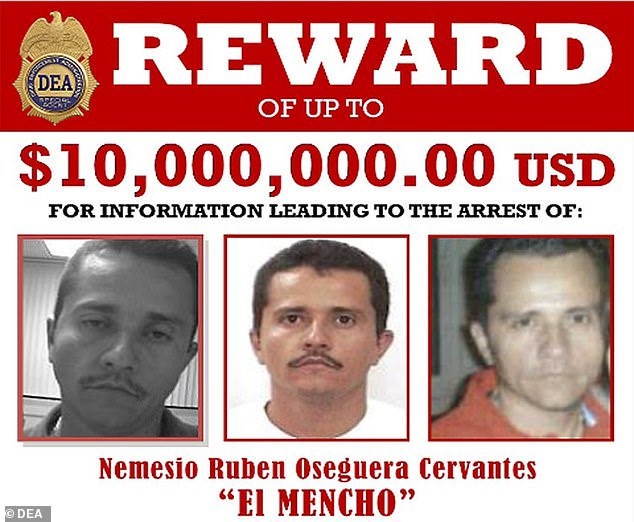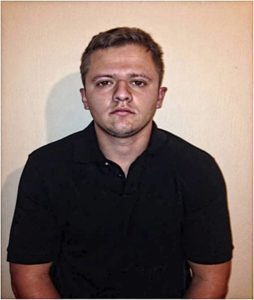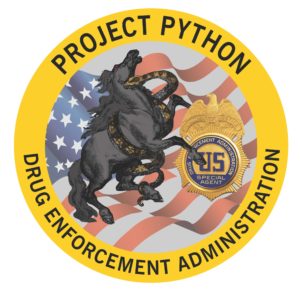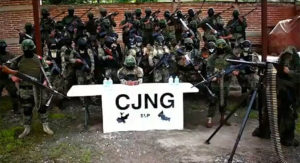DEA attacks top Mexican drug cartel with 600 arrests across U.S.
‘Project Python’ targeted Jalisco trafficking gang led by ‘El Mencho’

The operation was named “Project Python,” presumably reflecting an effort by federal law enforcement to squeeze the life out of its prey – members of a Mexican drug cartel described by the U.S. Justice Department as “one of the five most dangerous transnational criminal organizations in the world.”
The Justice Department and the Drug Enforcement Administration announced earlier this month that about 600 suspects across the United States were arrested on suspicion of taking part in a drug ring organized by the Cartel Jalisco Nueva Generacion (Jalisco New Generation cartel, or CJNG), based in southwest Mexico.
Project Python took place over six months, culminating in early March with the arrests, along with 350 grand jury indictments of CJNG defendants. The busts have included seizures of 44,000 pounds of drugs, according to a report by WLS Eyewitness News in Chicago.

Assistant Attorney General Brian A. Benczkowski of the Justice Department’s Criminal Division said the targeted attack on the CJNG followed the President’s Executive Order 13773 to identify and topple the largest crime groups in America.
“When President Trump signed an executive order prioritizing the dismantlement of transnational criminal organizations, the Department of Justice answered the call and took direct aim at CJNG,” Benczkowski said. “We deemed CJNG one the highest-priority transnational crime threats we face. And with Project Python, we are delivering results in the face of that threat for the American people.”
In addition to the arrests, the Justice Department and DEA, in a superseding indictment, enhanced the drug trafficking, murder conspiracy, firearms and criminal racketeering allegations against the widely acknowledged kingpin of CJNG, Nemesio Ruben Oseguera Cervantes, aka “El Mencho,” who remains at large.
U.S. authorities have apprehended two of El Mencho’s children, who are considered among the higher-ups in the CJNG. His son, Ruben Oseguera Gonzalez, whose nicknames include “Menchito,” “Rojo” and “El Nino,” is considered El Mencho’s second in command. He was formally extradited in February from Mexico to the United States to face charges of trafficking narcotics and using a gun to facilitate drug smuggling.

Meanwhile, on February 26, authorities located and arrested the kingpin’s daughter, Jessica Johanna Oseguera Gonzalez, aka “La Negra,” in the United States. In December, a federal grand jury indicted her on charges of laundering profits from CJNG’s international drug smuggling scheme. The indictment claims she owned an advertising business, cabin rental firm, sushi lounge and tequila company in Guadalajara, Mexico, to serve as fronts to hide CJNG’s money on behalf of her father.
In the three cases against El Mencho and his children, federal prosecutors asked the court to order the forfeiture to the U.S. government of all money, property and other gains the defendants received from the drug trafficking if they are convicted.
The Treasury Department has used the Foreign Narcotics Kingpin Designation Act to list El Mencho as a “specially designated narcotics trafficker,” and the U.S. State Department offered a $10 million reward for information leading to his arrest.
According to El Mencho’s indictment, the CJNG, from the Mexican state of Jalisco, worked with its drug trafficking partner, called Los Cuinis, to arrange the shipment of multiple tons of cocaine from Colombia and elsewhere in Latin America to Mexico. Both groups allegedly still oversee the transport and sales of the cocaine to the United States and supervise the movement of numerous kilos of methamphetamine and fentanyl to the States as well.
Prosecutors contend that El Mencho started trafficking cocaine and methamphetamine in 2000. By 2007, he allegedly distributed large quantities of narcotics in an international organization spanning Colombia, Guatemala, Mexico, the United States, Australia and elsewhere. The U.S. government also charged him with conspiring to kill or inducing others to kill one or more people.

Los Cuinis, as with CJNG, has been a family affair for years, led by members of the Gonzalez Valencia clan. The family patriarch, Abigael Gonzalez Valencia, ran the trafficking gang before his arrest in Mexico in 2015 (he is still awaiting extradition to the United States). His sister, Rosalinda Gonzalez Valencia, who is El Mencho’s wife, was released from a Mexican jail in 2018 following her arrest on money laundering and other charges. Some authorities maintain that Los Cuinis currently functions primarily as the money laundering wing of CJNG.
Abigael Gonzalez Valencia’s brother, Gerardo Gonzalez Valencia, known as “Lalo” and another leader of Los Cuinis, left Mexico to manage drug trafficking from Argentina and then Uruguay, a country seen as a haven for money laundering. But soon after he was charged with drug trafficking in the United States in 2016, authorities in Uruguay arrested him. His extradition to the U.S. is still pending.

In an indictment filed in Washington, D.C., in 2014, U.S. prosecutors charged that the “CJNG and Los Cuinis carried out numerous acts of violence, including murders, assaults, kidnappings, assassinations, and acts of torture.” The Justice Department has deemed the CJNG “one of the most dangerous transnational criminal organizations in the world.” The group smuggles as much as five tons of cocaine and methamphetamines into the United States on a monthly basis and smuggles in fentanyl-laced heroin as well. According to news reports, CJNG’s sphere of influence in the drug trade extends as far as Europe, North Africa and China.
The CJNG emerged as a powerful winner in 2011 during an internal struggle with a splinter group. Based in Guadalajara, CJNG exercised brute force, killing 35 gangsters in one battle and using a rocket-propelled grenade to shoot down a Mexican military helicopter. Years later, it made further gains in the confusion left after the arrest of Sinaloa cartel kingpin Joaquin “El Chapo” Guzman (now imprisoned in the U.S.). It also commands the illegal drug business in the Mexican states of Colima and Veracruz.
The crime gang is considered a significant reason for the high increase in murders that has befallen Mexico since 2014.
Feedback or questions? Email blog@themobmuseum.org





